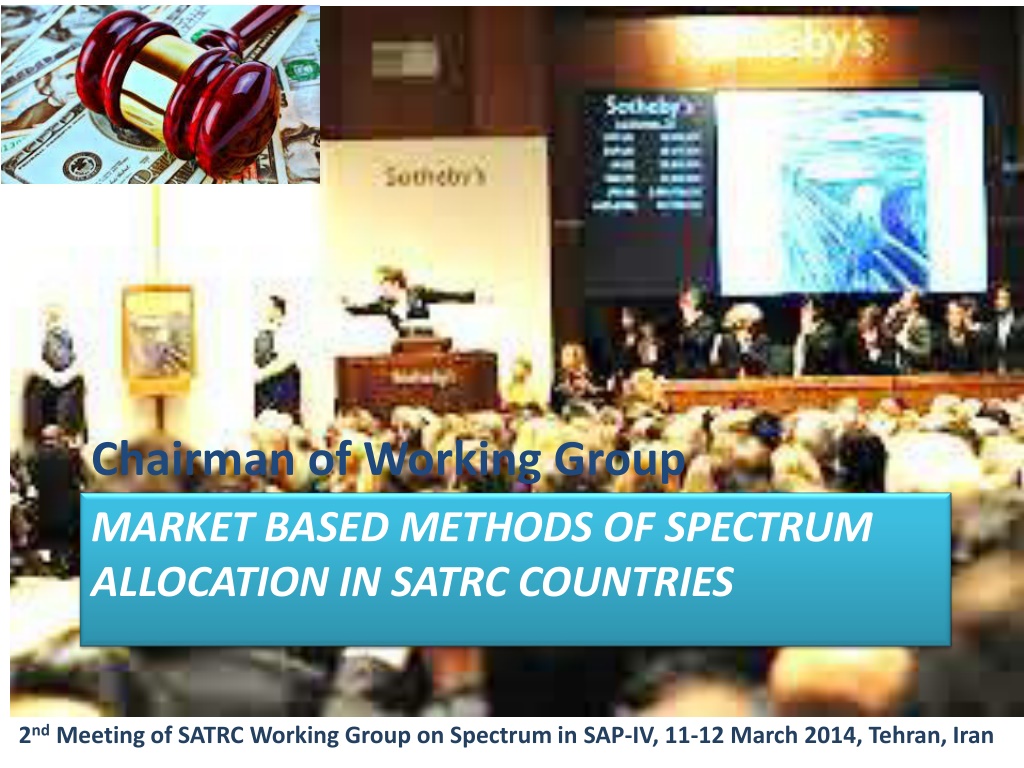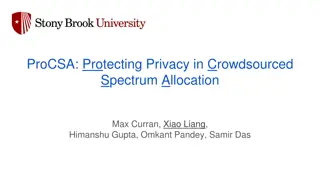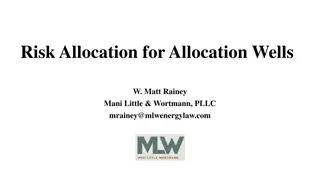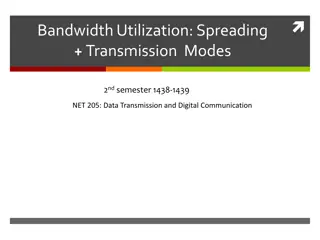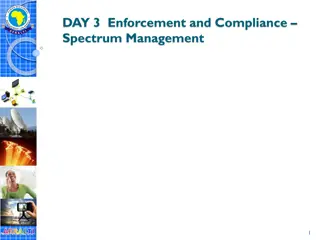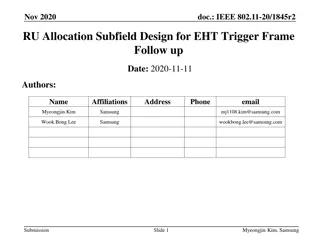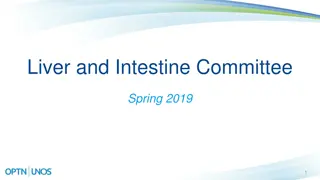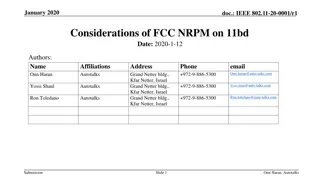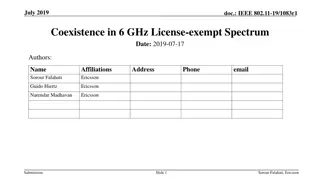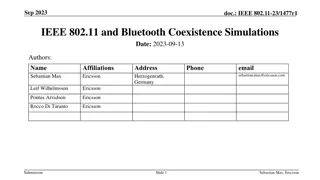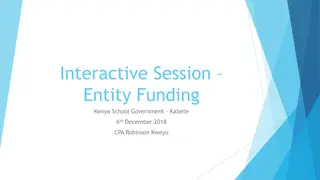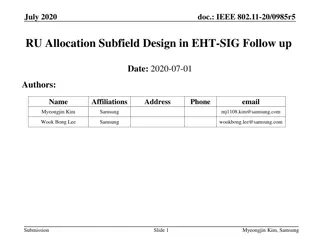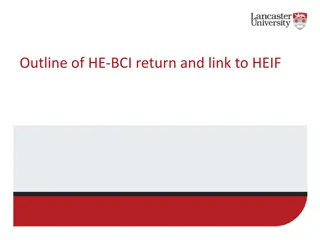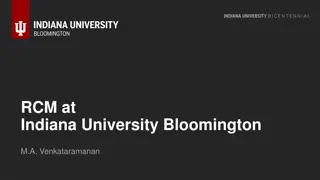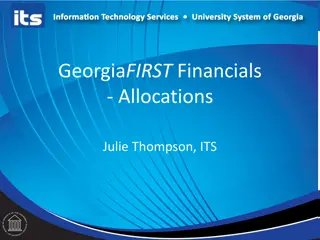Market-Based Spectrum Allocation Strategies in SATRC Countries
Explore the implementation of market-based methods for spectrum allocation in SATRC countries. Learn about the requirements, benefits, and challenges associated with adopting market-based mechanisms, especially in the context of increasing demand for spectrum and technological advancements. Discover how these strategies promote efficient spectrum use and foster competition in communication technologies.
Download Presentation

Please find below an Image/Link to download the presentation.
The content on the website is provided AS IS for your information and personal use only. It may not be sold, licensed, or shared on other websites without obtaining consent from the author. Download presentation by click this link. If you encounter any issues during the download, it is possible that the publisher has removed the file from their server.
E N D
Presentation Transcript
Chairman of Working Group MARKET BASED METHODS OF SPECTRUM ALLOCATION IN SATRC COUNTRIES 2nd Meeting of SATRC Working Group on Spectrum in SAP-IV, 11-12 March 2014, Tehran, Iran
Table of Contents Requirement for adopting Market based Mechanism Introduction of WI report Moving towards Market based approach non-market-based strategies for spectrum allocation and assignment Market-based strategies for spectrum allocation and assignment views of Ofcom
Contents of the WI report CHAPTER-I CHAPTER-II CHAPTER-III CHAPTER-IV INTRODUCTION ASSIGNMENT OF SPECTRUM MARKET BASED SPECTRUM MECHANISM: OTHER DIMENSIONS SATRC COUNTRIES PERSPECTIVE
General Requirement for adopting Market based Mechanism Moving towards Market based approach INTRODUCTION
Requirement for adopting Market based Mechanism ( 1) When the demand for the spectrum in any band is less than its availability, definitely, assignment of spectrum needs to be done over the counter on an administratively determined price. But, when the demand for a spectrum in band outstrips its availability considerably, the market based approach is best suited for ensuring the optimal use of the spectrum.
Requirement for adopting Market based Mechanism (2) The emergence of new services, particularly mobile wireless broadband, Demand for internationally harmonised spectrum
Requirement for adopting Market based Mechanism There is trend towards converging markets for integrated services through different communication technologies. Networks and services convergence and the rapid innovation have created a need for more flexible access to spectrum, than is possible under traditional methods.
Requirement for adopting Market based Mechanism The trend towards greater flexibility and more competition in spectrum use is facilitated through a market-based approach to individual rights of use. The market based methods puts resources in the hands of those who value them the most.
Moving towards Market based approach There has been a gradual shift from administrative approach towards the market based approach of spectrum management. There are some countries which allowed the auctioning of licences but did not permit trading and change of use.
Moving towards Market based approach On the other hand, there are some markets for spectrum and spectrum licences under which both the ownership and use of spectrum can change in the course of a licensee's operation. Methods of Assignment of frequency, removal of restrictions on the usage of spectrum rights, allowing the change in the ownership through spectrum trading are important tools that have been instrumental for this shift of approach
the allocation stage and the assignment stage first-come, first- served basis non-market- based strategies for spectrum allocation and assignment beauty contests
Non-market-based strategies for spectrum allocation and assignment Traditionally, non-market-based assignment approaches (administrative methods) were adopted by a number of countries for the assignment of spectrum. Minimizing harmful interference is the focal point in the traditional model which places an emphasis on the technical management of radio spectrum.
In the administrative method, there are two stages involved in authorizing spectrum use viz. administrative method spectrum use allocation stage assignment stage
ALLOCATION STAGE At the allocation stage, broad decisions on spectrum use are made on ITU world radio communication conferences. National spectrum regulators prepare their own allocation decisions, which are published in form of a National Frequency Allocation Table.
ASSIGNMENT STAGE Once an allocation has been determined, licences are issued to authorize the use of spectrum to particular users at the assignment stage with the issuance of a license(s) which is assigned.
ADMINISTRATIVE METHOD FOR THE ASSIGNMENT THE SPECTRUM Historically, assignments were made by methods such as first-come, first-served basis or by way of comparative evaluation (also known as beauty contests ) and/or consultation rather than by market based methods.
FIRST-COME, FIRST SERVED In the first-come, first served (FCFS) method, eligibility criteria is set. Subsequently, blocks of spectrum are assigned to eligible seekers on first-come first served basis. Where spectrum is not scarce and there is enough to meet the demand from all those who want it, FCFS may be suitable method for the assignment of spectrum.
BEAUTY CONTESTS Beauty contests is another commonly used administrative method for the assignment the spectrum. It requires those, who are interested in a particular tranche of spectrum, making proposals for how they intend to use it.
BEAUTY CONTESTS The regulator evaluates the proposals according to certain criteria, which may include proposed coverage commitments, speed of rollout, end-user prices, quality and range of services offered, etc. The spectrum management authority determines who the best qualified applicant to use the spectrum is and awards the licence.
BEAUTY CONTESTS The main problem with beauty contests is that, it is difficult to keep the selection procedure objective because they involve evaluation across a range of criteria which essentially have a subjective element. They are often subject to successful legal challenge and may delay the development of a truly competitive market, to the detriment of consumers interest. Beauty contests are also necessarily slow, since all the criteria must be evaluated in a way which will stand up to legal consideration.
Tradable spectrum Auctions License-exempt spectrum Market-based strategies for spectrum allocation and assignment Administrative incentive pricing Ofcom views
Market-based strategies for spectrum allocation and assignment Tradable spectrum rights License- exempt spectrum Administrative incentive pricing Auctions Ref. http://www.itu.int/ITU-D/treg/Events/Seminars/2004/GSR04/index.html.
Market-based strategies for spectrum allocation and assignment Auctions Types of auctions Advantages and disadvantages of auctions Ref. : http://www.itu.int/ITU-D/treg/Events/Seminars/2004/GSR04/index.html.
Market-based strategies for spectrum allocation and assignment Types of auctions the English auction the first-price sealed bid auction the second-price sealed bid auction the Dutch auction the simultaneous multiple round auction http://www.itu.int/ITU-D/treg/Events/Seminars/2004/GSR04/index.html.
Market-based strategies for spectrum allocation and assignment Advantages efficient mechanism of assigning commercial spectrum licenses for which there is a high demand. to decrease the administrative costs and time associated with the spectrum assignment process licenses are competitively assigned to users who value these licenses the most lucrative source of income for government
Market-based strategies for spectrum allocation and assignment Disadvantages Unpredictable delay in the rollout of infrastructure and services requires a tailored approach, adapted to the particular circumstances of a country
Market-based strategies for spectrum allocation and assignment Tradable spectrum rights change of ownership and reconfiguration change of ownership change of ownership, reconfiguration and change of use change of ownership and change of use
Market-based strategies for spectrum allocation and assignment Spectrum trading variants also include: spectrum sharing Spectrum leasing
Market-based strategies for spectrum allocation and assignment License-exempt spectrum Open access spectrum Spectrum commons
Market-based strategies for spectrum allocation and assignment Open access spectrum License-exempt spectrum use is usually permitted in two forms low power transmissions spectrum use in bands allocated for license-exempt use (ISM)
Market-based strategies for spectrum allocation and assignment Administrative incentive pricing Administrative Incentive Pricing (AIP) is a fee charged to users of the spectrum to encourage them to make economically efficient use of the spectrum. Licenses are issued through an administrative process, usually on a first come first served basis, and carry with them an obligation to make a regular payments to the regulator or government agency. The idea is that AIP will give the owner of the license an incentive to return unused spectrum rather than pay the fee. It may also help a licensee to use the spectrum more efficiently.
Market-based strategies for spectrum allocation and assignment Administrative incentive pricing The fee is usually based on the opportunity costs of the use of spectrum. Opportunity costs can be based on three different principles: The value of the spectrum for a user with another service. The additional costs if the service had to make use of other means. The additional costs if the licensee had to make use of less spectrum.
Ofcom views Combining market mechanisms and regulatory action to deliver optimal spectrum use Spectrum management strategy -Ofcom s approach to and priorities for spectrum management over the next ten years- 2 October 2013
In order to deliver optimal spectrum use, ofcom relies on market mechanisms where possible and effective, but also take regulatory action where necessary. Once the conditions required for the use of market mechanisms are in place, they are generally considered the most effective method of allocating scarce resources to ensure they are used efficiently. Spectrum management strategy -Ofcom s approach to and priorities for spectrum management over the next ten years- 2 October 2013
auctions as a means to assign new spectrum access rights for large blocks of spectrum 2005 Spectrum Framework Review 4G auction at 800 MHz and 2.6 GHz spectrum pricing to create incentives for users to make efficient use of spectrum 2005 Spectrum Framework spectrum trading and leasing as the means for spectrum access rights that are already assigned to change hands 84% of spectrum is tradable greater license flexibility ( liberalization ) as a principle to enable change of use 21% of spectrum
there can be an important and complementary role for regulators to play in addressing situations where market mechanisms alone are unlikely to deliver the greatest value to society from spectrum use. Spectrum management strategy -Ofcom s approach to and priorities for spectrum management over the next ten years- 2 October 2013
situations where market mechanisms alone are unlikely to deliver the greatest value to society from spectrum use often arise when major changes in spectrum use are contemplated. This is because, typically, major changes of use involve one or more of the factors in the next slide Spectrum management strategy -Ofcom s approach to and priorities for spectrum management over the next ten years- 2 October 2013
Changes to international agreements Implications for competition in relevant markets Clearance and mitigation of co-existence challenges Spectrum management strategy -Ofcom s approach to and priorities for spectrum management over the next ten years- 2 October 2013
Conclusion There are a large number of policy options for a country to select from when migrating to a more technology-focused, market-based spectrum management. Approaches such as auctions, administrative incentive pricing, spectrum trading, and dedicating more frequencies for license-exempt use represent different levels of spectrum liberalization countries can choose from. The experience of the pioneering regulators such as Ofcom appears to suggest that the gradual introduction of a mix of technology focused and market based approaches across different spectrum bands would be the best overall approach approach to
Thank you for your attention Any questions Dr. Mina Dashti Chairman of WG on Spectrum
